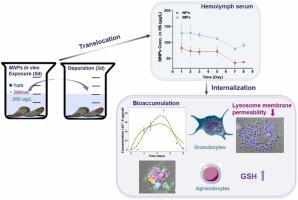In vivo Bioaccumulation and Responses of Hemocytes of Mussels Perna viridis to Microplastics and Nanoplastics Exposure
IF 12.2
1区 环境科学与生态学
Q1 ENGINEERING, ENVIRONMENTAL
引用次数: 0
Abstract
Growing micro- and nano-plastic (MNPs) pollution in the environment poses a threat to marine animals. Due to their excellent filtration capacity, bivalves can easily ingest MNPs, which could be translocated to open circulation system with potential risks. In the present study, the accumulation and elimination of MNPs (200 nm and 1 µm) in the mussel hemolymph serum and hemocytes were firstly quantified, and the differential sensitive responses of two subpopulations of hemocytes were then explored by in vivo exposure under environmentally relevant concentration of MNPs (200 µg/L). We demonstrated that MNPs were readily translocated into hemolymph serum, but were immediately followed by efficient internalization by hemocytes. Remarkably, concentrations of MNPs in hemolymph were only 0.63 and 0.385 times lower than the ambient exposure concentration. Granulocytes displayed a much higher potential of accumulating MNPs than the agranulocytes. MPs were more readily internalized by granulocytes, with their estimated maximum bioaccumulation factor (BCF) of 0.29 L/g. Due to the primary function of phagocytic encapsulation of MNPs by granulocytes, lysosome features especially the decline of subsequent lysosome membrane potential could be a potential sensitive biomarker in response to MNPs exposure. Our results provided insights on the bioaccumulation of MNPs at the cellular levels in marine bivalves.

贻贝(Perna viridis)血细胞对微塑料和纳米塑料暴露的体内生物累积和反应
环境中日益严重的微塑料和纳米塑料(MNPs)污染对海洋动物构成了威胁。由于双壳贝类具有出色的过滤能力,它们很容易摄入 MNPs,并将其转移到开放的循环系统中,从而带来潜在风险。本研究首先量化了 MNPs(200 nm 和 1 µm)在贻贝血淋巴血清和血细胞中的积累和消除情况,然后通过在体内暴露于环境相关浓度的 MNPs(200 µg/L),探讨了两个亚群血细胞的不同敏感反应。我们的研究表明,MNPs 很容易转运到血淋巴血清中,但紧接着就会被血细胞高效内化。值得注意的是,MNPs 在血淋巴中的浓度仅比环境暴露浓度低 0.63 和 0.385 倍。粒细胞积聚 MNP 的潜力远高于粒细胞。颗粒细胞更容易内化 MPs,其最大生物累积系数 (BCF) 估计为 0.29 升/克。由于粒细胞具有吞噬包裹 MNPs 的主要功能,溶酶体特征(尤其是随后溶酶体膜电位的下降)可能是反应 MNPs 暴露的潜在敏感生物标志物。我们的研究结果为海洋双壳类动物细胞水平的 MNPs 生物累积提供了见解。
本文章由计算机程序翻译,如有差异,请以英文原文为准。
求助全文
约1分钟内获得全文
求助全文
来源期刊

Journal of Hazardous Materials
工程技术-工程:环境
CiteScore
25.40
自引率
5.90%
发文量
3059
审稿时长
58 days
期刊介绍:
The Journal of Hazardous Materials serves as a global platform for promoting cutting-edge research in the field of Environmental Science and Engineering. Our publication features a wide range of articles, including full-length research papers, review articles, and perspectives, with the aim of enhancing our understanding of the dangers and risks associated with various materials concerning public health and the environment. It is important to note that the term "environmental contaminants" refers specifically to substances that pose hazardous effects through contamination, while excluding those that do not have such impacts on the environment or human health. Moreover, we emphasize the distinction between wastes and hazardous materials in order to provide further clarity on the scope of the journal. We have a keen interest in exploring specific compounds and microbial agents that have adverse effects on the environment.
 求助内容:
求助内容: 应助结果提醒方式:
应助结果提醒方式:


